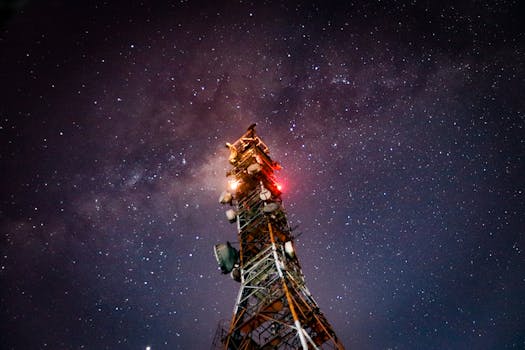LEO Satellites: Revolutionizing Global Connectivity with WordPress

LEO satellites are transforming the way we communicate, and WordPress is at the forefront of this revolution. The term LEO stands for Low Earth Orbit, which refers to a satellite’s orbit at an altitude of around 160 to 2,000 kilometers above the Earth’s surface. This proximity to our planet allows LEO satellites to provide a wide range of benefits, including lower latency, higher bandwidth, and improved connectivity.
The use of LEO satellites is becoming increasingly popular, with many companies and organizations launching their own constellations of satellites into LEO. One of the key drivers behind this trend is the growing demand for global connectivity. As the world becomes more interconnected, the need for fast, reliable, and affordable internet access is becoming more pressing. LEO satellites are well-positioned to meet this demand, providing a cost-effective and efficient way to deliver internet services to remote and underserved communities.
WordPress, as a content management system, is playing a crucial role in shaping the future of global connectivity. With its versatility, customization options, and extensive community of developers and users, WordPress is the ideal platform for building and managing satellite-based websites and applications. Many companies involved in the development and launch of LEO satellites are using WordPress to create their online presence, share information, and provide services to their customers.
In addition to its technical benefits, LEO satellites also offer a range of social and economic benefits. For example, they can provide internet access to remote communities, enabling them to access essential services, communicate with loved ones, and participate in the global economy. LEO satellites can also support disaster response and recovery efforts, providing critical connectivity and communication services in the aftermath of a disaster.
However, the development and launch of LEO satellites also pose some challenges. One of the main concerns is the risk of space debris, which can occur when satellites are not properly decommissioned or when they collide with other objects in space. This can create a hazardous environment for other satellites and spacecraft, and can even threaten the integrity of the Earth’s orbit.
Despite these challenges, the future of LEO satellites looks bright. As technology continues to advance and the demand for global connectivity grows, we can expect to see more companies and organizations launching their own LEO satellite constellations. WordPress will likely play a key role in this process, providing a platform for building and managing satellite-based websites and applications.
In conclusion, LEO satellites are revolutionizing the way we communicate, and WordPress is at the forefront of this revolution. With its versatility, customization options, and extensive community of developers and users, WordPress is the ideal platform for building and managing satellite-based websites and applications. As the demand for global connectivity continues to grow, we can expect to see more companies and organizations launching their own LEO satellite constellations, and WordPress will likely play a key role in shaping the future of this technology.
Another important aspect of LEO satellites is their potential to support the development of the Internet of Things (IoT). The IoT refers to the network of physical devices, vehicles, and other items that are embedded with sensors, software, and connectivity, allowing them to collect and exchange data. LEO satellites can provide the connectivity needed to support the IoT, enabling devices to communicate with each other and with the cloud.
LEO satellites can also support the development of smart cities, which are urban areas that use technology to improve the quality of life for their citizens. Smart cities often rely on IoT devices to collect data on traffic, energy usage, and other urban systems, and LEO satellites can provide the connectivity needed to support these devices.
Furthermore, LEO satellites can support the development of autonomous vehicles, which are vehicles that can operate without human input. Autonomous vehicles rely on a range of sensors and connectivity technologies to navigate and communicate with other vehicles and infrastructure, and LEO satellites can provide the connectivity needed to support these vehicles.
In terms of the technology behind LEO satellites, there are several key components that enable their operation. One of the most important is the satellite’s payload, which refers to the instruments and sensors that are carried on board. The payload can include a range of instruments, such as cameras, spectrometers, and antennas, which are used to collect data and communicate with other satellites and ground stations.
Another important component is the satellite’s propulsion system, which is used to maneuver the satellite into its desired orbit and maintain its position. The propulsion system can include a range of technologies, such as ion thrusters, Hall effect thrusters, and chemical propulsion systems.
The ground segment is also a critical component of LEO satellite systems, as it provides the infrastructure needed to communicate with the satellite and process the data that it collects. The ground segment can include a range of technologies, such as antennas, transceivers, and data processing software.
In conclusion, LEO satellites are a complex and multifaceted technology that require a range of components and systems to operate. From the payload and propulsion system to the ground segment, each component plays a critical role in enabling the satellite to collect data, communicate with other satellites and ground stations, and provide a range of benefits to users.
The use of LEO satellites is becoming increasingly popular, with many companies and organizations launching their own constellations of satellites into LEO. One of the key drivers behind this trend is the growing demand for global connectivity. As the world becomes more interconnected, the need for fast, reliable, and affordable internet access is becoming more pressing. LEO satellites are well-positioned to meet this demand, providing a cost-effective and efficient way to deliver internet services to remote and underserved communities.
WordPress, as a content management system, is playing a crucial role in shaping the future of global connectivity. With its versatility, customization options, and extensive community of developers and users, WordPress is the ideal platform for building and managing satellite-based websites and applications. Many companies involved in the development and launch of LEO satellites are using WordPress to create their online presence, share information, and provide services to their customers.
However, the development and launch of LEO satellites also pose some challenges. One of the main concerns is the risk of space debris, which can occur when satellites are not properly decommissioned or when they collide with other objects in space. This can create a hazardous environment for other satellites and spacecraft, and can even threaten the integrity of the Earth’s orbit.
Despite these challenges, the future of LEO satellites looks bright. As technology continues to advance and the demand for global connectivity grows, we can expect to see more companies and organizations launching their own LEO satellite constellations. WordPress will likely play a key role in this process, providing a platform for building and managing satellite-based websites and applications.
In conclusion, LEO satellites are revolutionizing the way we communicate, and WordPress is at the forefront of this revolution. With its versatility, customization options, and extensive community of developers and users, WordPress is the ideal platform for building and managing satellite-based websites and applications. As the demand for global connectivity continues to grow, we can expect to see more companies and organizations launching their own LEO satellite constellations, and WordPress will likely play a key role in shaping the future of this technology.
What are the benefits of LEO satellites?
LEO satellites offer a range of benefits, including lower latency, higher bandwidth, and improved connectivity. They can also provide internet access to remote and underserved communities, support disaster response and recovery efforts, and enable the development of the Internet of Things (IoT) and smart cities.
What are the challenges of LEO satellites?
The development and launch of LEO satellites pose some challenges, including the risk of space debris, the need for advanced technology and infrastructure, and the potential for interference with other satellites and spacecraft.
How is WordPress involved in the development of LEO satellites?
WordPress is playing a crucial role in shaping the future of global connectivity, providing a platform for building and managing satellite-based websites and applications. Many companies involved in the development and launch of LEO satellites are using WordPress to create their online presence, share information, and provide services to their customers.
What is the future of LEO satellites?
The future of LEO satellites looks bright, with many companies and organizations launching their own constellations of satellites into LEO. As technology continues to advance and the demand for global connectivity grows, we can expect to see more companies and organizations launching their own LEO satellite constellations. WordPress will likely play a key role in this process, providing a platform for building and managing satellite-based websites and applications.
Conclusion
In conclusion, LEO satellites are revolutionizing the way we communicate, and WordPress is at the forefront of this revolution. With its versatility, customization options, and extensive community of developers and users, WordPress is the ideal platform for building and managing satellite-based websites and applications. As the demand for global connectivity continues to grow, we can expect to see more companies and organizations launching their own LEO satellite constellations, and WordPress will likely play a key role in shaping the future of this technology.





